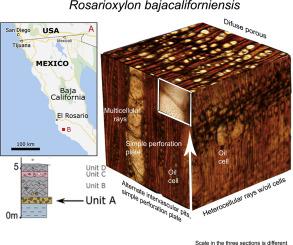Review of Palaeobotany and Palynology ( IF 1.7 ) Pub Date : 2021-06-24 , DOI: 10.1016/j.revpalbo.2021.104478 Sergio R.S. Cevallos-Ferriz , Amanda Santa Catharina , Ben Kneller

|
A new wood type for the Baja California Cretaceous adds to the plant diversity so far known for the area where gymnosperms seem to be dominant. It was collected near El Rosario, Baja California, from rocks of the Rosario Formation, in a sedimentary sequence that comprises ca. 1200 m of non-marine to deep marine sediments from Upper Campanian to Lower Danian age. The wood is characterized by having semiring porous growth rings, predominantly radial multiples of 2–7 with occasional clusters and some solitary vessels, simple perforation plates, alternate intervascular pits, oval to large elliptical vessel element-ray pits with reduced borders, septate thin-walled fibers, 1–4 seriate heterocellular rays, scares paratracheal, vasicentric and marginal parenchyma and oil cells associated with ray parenchyma. All these characters are found in Lauraceae, however, none of the extant taxa of the family have all these characters and even among fossil woods the characters in the Baja California material are better described only among the diverse Laurinoxylon, but vessel grouping, growth ring type, absence of marginal parenchyma, and slightly thicker rays suggest the presence of a new taxon, Rosarioxylon bajacaliforniensis Cevallos-Ferriz, Catharina & Kneller. By the end of the Cretaceous the family formed part of the plant community that represents a western extension of vegetation types more completely described from areas in the margins of the southern limits of the Western Interior Sea. The new taxon is proposed to highlight anatomical differences and geographic isolation from similar taxa and further suggests a large distribution of Lauraceae in what appears to be conifer dominated communities.
中文翻译:

来自墨西哥下加利福尼亚州 El Rosario 的白垩纪樟科木材
下加利福尼亚白垩纪的一种新木材类型增加了迄今为止以裸子植物似乎占主导地位的地区而闻名的植物多样性。它是在下加利福尼亚州埃尔罗萨里奥附近从罗萨里奥组的岩石中收集的,沉积序列包括约 从上坎帕阶到下大年阶的 1200 米非海相到深海沉积物。木材的特征是具有半环状多孔年轮,主要为 2-7 的径向倍数,偶尔有簇生和一些孤立的血管,简单的穿孔板,交替的血管间凹坑,椭圆形到大椭圆形血管元素射线凹坑,边缘减少,分隔薄-壁纤维,1-4 列异细胞射线,气管旁,血管中心和边缘薄壁组织以及与射线薄壁组织相关的油细胞。所有这些性状都在樟科中发现,Laurinoxylon,但血管分组,年轮类型,没有边缘薄壁组织,和稍厚的射线表明存在一个新的分类群,Rosarioxylon bajacaliforniensis Cevallos-Ferriz, Catharina & Kneller。到白垩纪末期,该科形成了植物群落的一部分,代表了西部内海南部边缘地区更完整地描述的植被类型的西部延伸。新分类群旨在突出与类似分类群的解剖学差异和地理隔离,并进一步表明樟科在似乎以针叶树为主的群落中的大量分布。













































 京公网安备 11010802027423号
京公网安备 11010802027423号